Alleviating the Prevalence of Smoking in Hong Kong
VerifiedAdded on 2023/06/04
|9
|2137
|178
AI Summary
The report explores the cultural and social factors that can be harnessed to alleviate the prevalence of smoking in Hong Kong. It discusses the measures adopted by the government and other agencies to strengthen tobacco control policies. The report also highlights the need to factor in social and cultural aspects which affect tobacco smoking and provides a conceptual framework that could be useful in understanding the social and cultural aspects which form the basis for the prevalence of tobacco smoking.
Contribute Materials
Your contribution can guide someone’s learning journey. Share your
documents today.

Running Head: Nursing Assignment
Nursing Assignment
Institution
Name
Date
Nursing Assignment
Institution
Name
Date
Secure Best Marks with AI Grader
Need help grading? Try our AI Grader for instant feedback on your assignments.
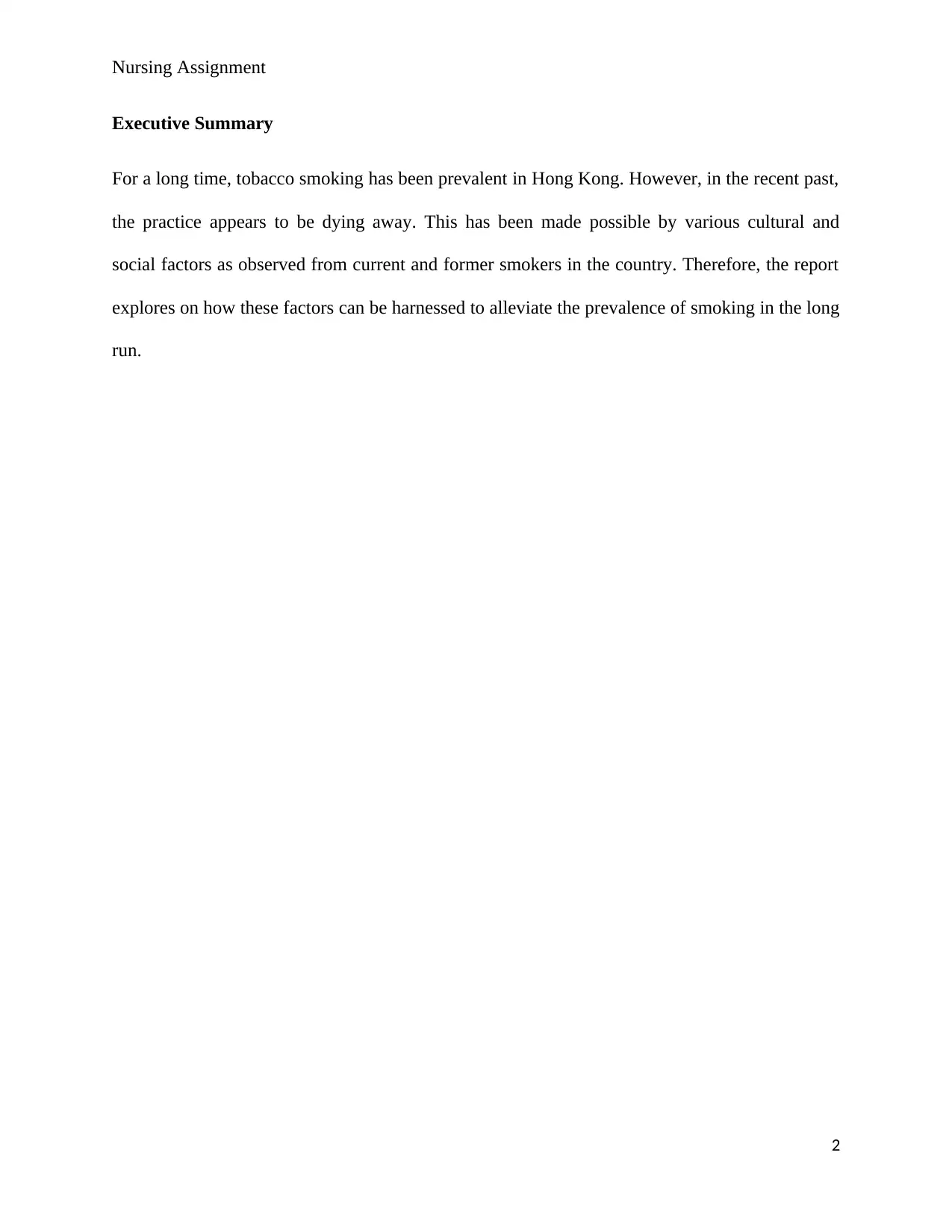
Nursing Assignment
Executive Summary
For a long time, tobacco smoking has been prevalent in Hong Kong. However, in the recent past,
the practice appears to be dying away. This has been made possible by various cultural and
social factors as observed from current and former smokers in the country. Therefore, the report
explores on how these factors can be harnessed to alleviate the prevalence of smoking in the long
run.
2
Executive Summary
For a long time, tobacco smoking has been prevalent in Hong Kong. However, in the recent past,
the practice appears to be dying away. This has been made possible by various cultural and
social factors as observed from current and former smokers in the country. Therefore, the report
explores on how these factors can be harnessed to alleviate the prevalence of smoking in the long
run.
2
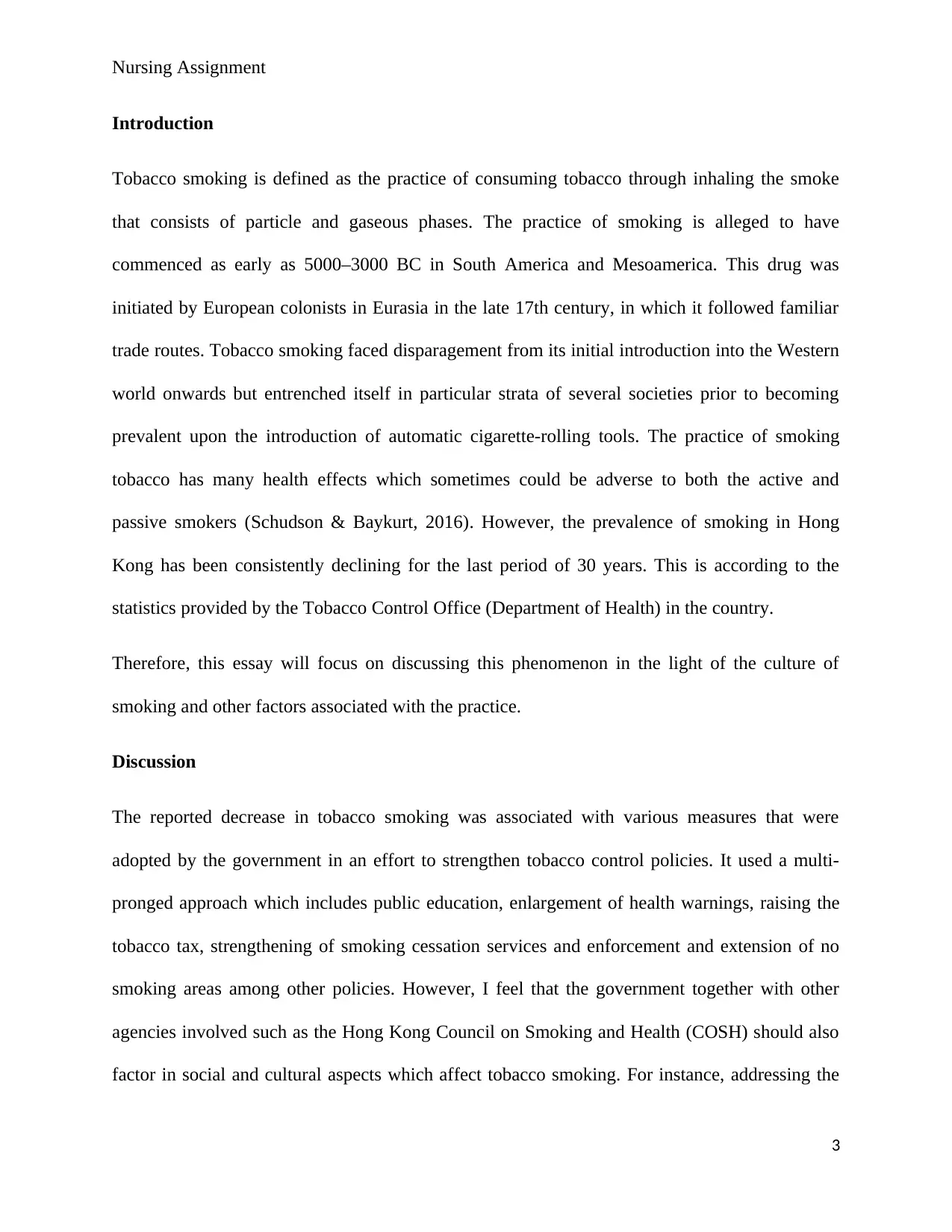
Nursing Assignment
Introduction
Tobacco smoking is defined as the practice of consuming tobacco through inhaling the smoke
that consists of particle and gaseous phases. The practice of smoking is alleged to have
commenced as early as 5000–3000 BC in South America and Mesoamerica. This drug was
initiated by European colonists in Eurasia in the late 17th century, in which it followed familiar
trade routes. Tobacco smoking faced disparagement from its initial introduction into the Western
world onwards but entrenched itself in particular strata of several societies prior to becoming
prevalent upon the introduction of automatic cigarette-rolling tools. The practice of smoking
tobacco has many health effects which sometimes could be adverse to both the active and
passive smokers (Schudson & Baykurt, 2016). However, the prevalence of smoking in Hong
Kong has been consistently declining for the last period of 30 years. This is according to the
statistics provided by the Tobacco Control Office (Department of Health) in the country.
Therefore, this essay will focus on discussing this phenomenon in the light of the culture of
smoking and other factors associated with the practice.
Discussion
The reported decrease in tobacco smoking was associated with various measures that were
adopted by the government in an effort to strengthen tobacco control policies. It used a multi-
pronged approach which includes public education, enlargement of health warnings, raising the
tobacco tax, strengthening of smoking cessation services and enforcement and extension of no
smoking areas among other policies. However, I feel that the government together with other
agencies involved such as the Hong Kong Council on Smoking and Health (COSH) should also
factor in social and cultural aspects which affect tobacco smoking. For instance, addressing the
3
Introduction
Tobacco smoking is defined as the practice of consuming tobacco through inhaling the smoke
that consists of particle and gaseous phases. The practice of smoking is alleged to have
commenced as early as 5000–3000 BC in South America and Mesoamerica. This drug was
initiated by European colonists in Eurasia in the late 17th century, in which it followed familiar
trade routes. Tobacco smoking faced disparagement from its initial introduction into the Western
world onwards but entrenched itself in particular strata of several societies prior to becoming
prevalent upon the introduction of automatic cigarette-rolling tools. The practice of smoking
tobacco has many health effects which sometimes could be adverse to both the active and
passive smokers (Schudson & Baykurt, 2016). However, the prevalence of smoking in Hong
Kong has been consistently declining for the last period of 30 years. This is according to the
statistics provided by the Tobacco Control Office (Department of Health) in the country.
Therefore, this essay will focus on discussing this phenomenon in the light of the culture of
smoking and other factors associated with the practice.
Discussion
The reported decrease in tobacco smoking was associated with various measures that were
adopted by the government in an effort to strengthen tobacco control policies. It used a multi-
pronged approach which includes public education, enlargement of health warnings, raising the
tobacco tax, strengthening of smoking cessation services and enforcement and extension of no
smoking areas among other policies. However, I feel that the government together with other
agencies involved such as the Hong Kong Council on Smoking and Health (COSH) should also
factor in social and cultural aspects which affect tobacco smoking. For instance, addressing the
3
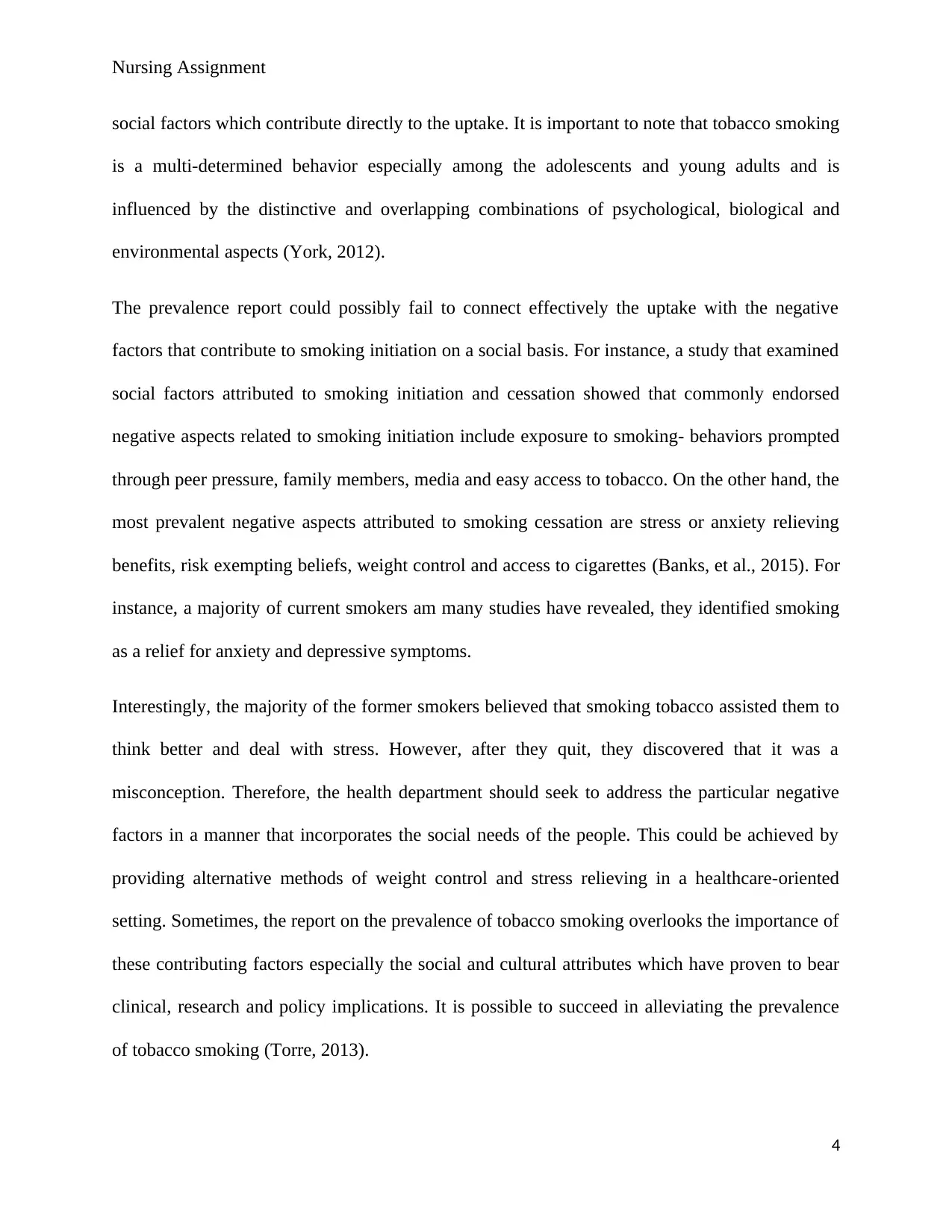
Nursing Assignment
social factors which contribute directly to the uptake. It is important to note that tobacco smoking
is a multi-determined behavior especially among the adolescents and young adults and is
influenced by the distinctive and overlapping combinations of psychological, biological and
environmental aspects (York, 2012).
The prevalence report could possibly fail to connect effectively the uptake with the negative
factors that contribute to smoking initiation on a social basis. For instance, a study that examined
social factors attributed to smoking initiation and cessation showed that commonly endorsed
negative aspects related to smoking initiation include exposure to smoking- behaviors prompted
through peer pressure, family members, media and easy access to tobacco. On the other hand, the
most prevalent negative aspects attributed to smoking cessation are stress or anxiety relieving
benefits, risk exempting beliefs, weight control and access to cigarettes (Banks, et al., 2015). For
instance, a majority of current smokers am many studies have revealed, they identified smoking
as a relief for anxiety and depressive symptoms.
Interestingly, the majority of the former smokers believed that smoking tobacco assisted them to
think better and deal with stress. However, after they quit, they discovered that it was a
misconception. Therefore, the health department should seek to address the particular negative
factors in a manner that incorporates the social needs of the people. This could be achieved by
providing alternative methods of weight control and stress relieving in a healthcare-oriented
setting. Sometimes, the report on the prevalence of tobacco smoking overlooks the importance of
these contributing factors especially the social and cultural attributes which have proven to bear
clinical, research and policy implications. It is possible to succeed in alleviating the prevalence
of tobacco smoking (Torre, 2013).
4
social factors which contribute directly to the uptake. It is important to note that tobacco smoking
is a multi-determined behavior especially among the adolescents and young adults and is
influenced by the distinctive and overlapping combinations of psychological, biological and
environmental aspects (York, 2012).
The prevalence report could possibly fail to connect effectively the uptake with the negative
factors that contribute to smoking initiation on a social basis. For instance, a study that examined
social factors attributed to smoking initiation and cessation showed that commonly endorsed
negative aspects related to smoking initiation include exposure to smoking- behaviors prompted
through peer pressure, family members, media and easy access to tobacco. On the other hand, the
most prevalent negative aspects attributed to smoking cessation are stress or anxiety relieving
benefits, risk exempting beliefs, weight control and access to cigarettes (Banks, et al., 2015). For
instance, a majority of current smokers am many studies have revealed, they identified smoking
as a relief for anxiety and depressive symptoms.
Interestingly, the majority of the former smokers believed that smoking tobacco assisted them to
think better and deal with stress. However, after they quit, they discovered that it was a
misconception. Therefore, the health department should seek to address the particular negative
factors in a manner that incorporates the social needs of the people. This could be achieved by
providing alternative methods of weight control and stress relieving in a healthcare-oriented
setting. Sometimes, the report on the prevalence of tobacco smoking overlooks the importance of
these contributing factors especially the social and cultural attributes which have proven to bear
clinical, research and policy implications. It is possible to succeed in alleviating the prevalence
of tobacco smoking (Torre, 2013).
4
Secure Best Marks with AI Grader
Need help grading? Try our AI Grader for instant feedback on your assignments.
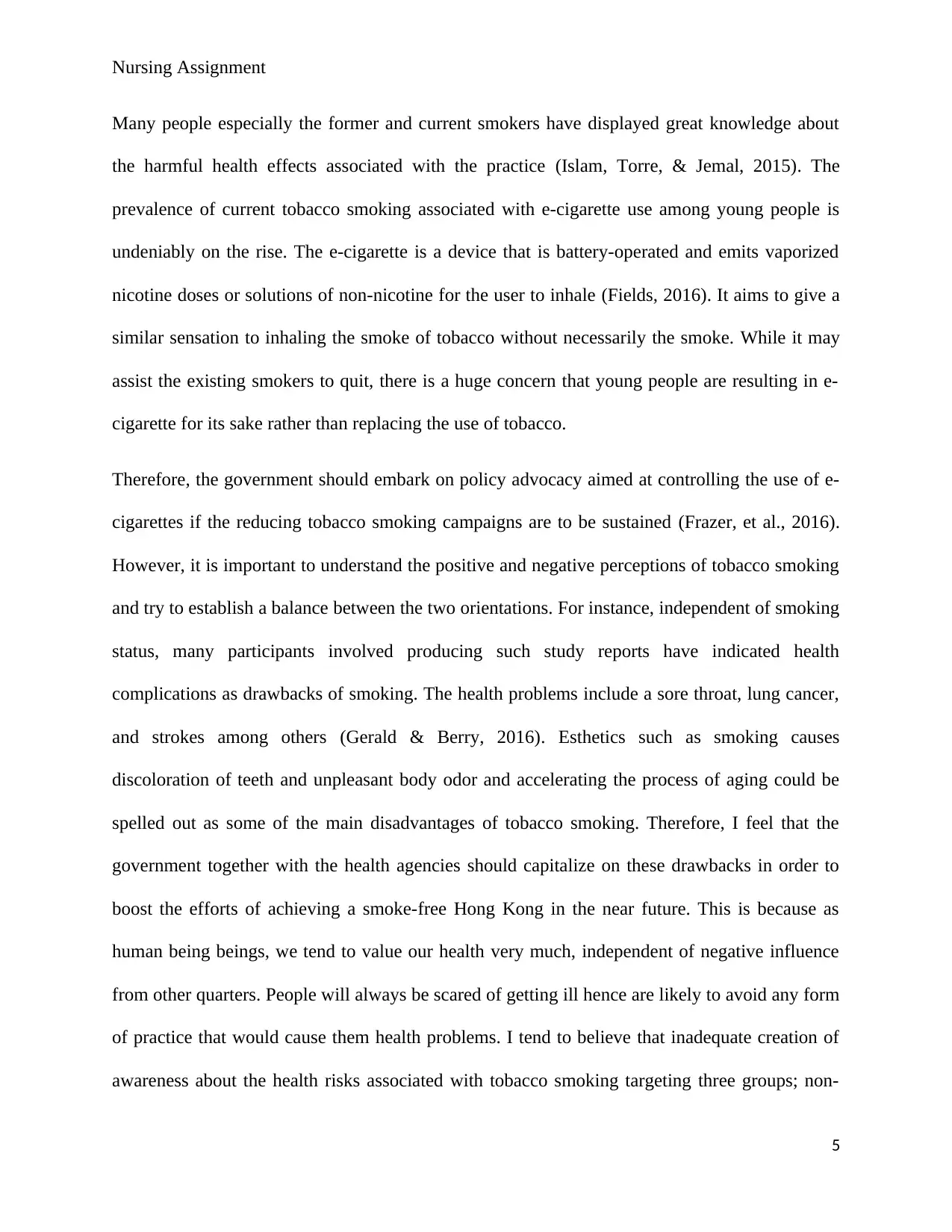
Nursing Assignment
Many people especially the former and current smokers have displayed great knowledge about
the harmful health effects associated with the practice (Islam, Torre, & Jemal, 2015). The
prevalence of current tobacco smoking associated with e-cigarette use among young people is
undeniably on the rise. The e-cigarette is a device that is battery-operated and emits vaporized
nicotine doses or solutions of non-nicotine for the user to inhale (Fields, 2016). It aims to give a
similar sensation to inhaling the smoke of tobacco without necessarily the smoke. While it may
assist the existing smokers to quit, there is a huge concern that young people are resulting in e-
cigarette for its sake rather than replacing the use of tobacco.
Therefore, the government should embark on policy advocacy aimed at controlling the use of e-
cigarettes if the reducing tobacco smoking campaigns are to be sustained (Frazer, et al., 2016).
However, it is important to understand the positive and negative perceptions of tobacco smoking
and try to establish a balance between the two orientations. For instance, independent of smoking
status, many participants involved producing such study reports have indicated health
complications as drawbacks of smoking. The health problems include a sore throat, lung cancer,
and strokes among others (Gerald & Berry, 2016). Esthetics such as smoking causes
discoloration of teeth and unpleasant body odor and accelerating the process of aging could be
spelled out as some of the main disadvantages of tobacco smoking. Therefore, I feel that the
government together with the health agencies should capitalize on these drawbacks in order to
boost the efforts of achieving a smoke-free Hong Kong in the near future. This is because as
human being beings, we tend to value our health very much, independent of negative influence
from other quarters. People will always be scared of getting ill hence are likely to avoid any form
of practice that would cause them health problems. I tend to believe that inadequate creation of
awareness about the health risks associated with tobacco smoking targeting three groups; non-
5
Many people especially the former and current smokers have displayed great knowledge about
the harmful health effects associated with the practice (Islam, Torre, & Jemal, 2015). The
prevalence of current tobacco smoking associated with e-cigarette use among young people is
undeniably on the rise. The e-cigarette is a device that is battery-operated and emits vaporized
nicotine doses or solutions of non-nicotine for the user to inhale (Fields, 2016). It aims to give a
similar sensation to inhaling the smoke of tobacco without necessarily the smoke. While it may
assist the existing smokers to quit, there is a huge concern that young people are resulting in e-
cigarette for its sake rather than replacing the use of tobacco.
Therefore, the government should embark on policy advocacy aimed at controlling the use of e-
cigarettes if the reducing tobacco smoking campaigns are to be sustained (Frazer, et al., 2016).
However, it is important to understand the positive and negative perceptions of tobacco smoking
and try to establish a balance between the two orientations. For instance, independent of smoking
status, many participants involved producing such study reports have indicated health
complications as drawbacks of smoking. The health problems include a sore throat, lung cancer,
and strokes among others (Gerald & Berry, 2016). Esthetics such as smoking causes
discoloration of teeth and unpleasant body odor and accelerating the process of aging could be
spelled out as some of the main disadvantages of tobacco smoking. Therefore, I feel that the
government together with the health agencies should capitalize on these drawbacks in order to
boost the efforts of achieving a smoke-free Hong Kong in the near future. This is because as
human being beings, we tend to value our health very much, independent of negative influence
from other quarters. People will always be scared of getting ill hence are likely to avoid any form
of practice that would cause them health problems. I tend to believe that inadequate creation of
awareness about the health risks associated with tobacco smoking targeting three groups; non-
5
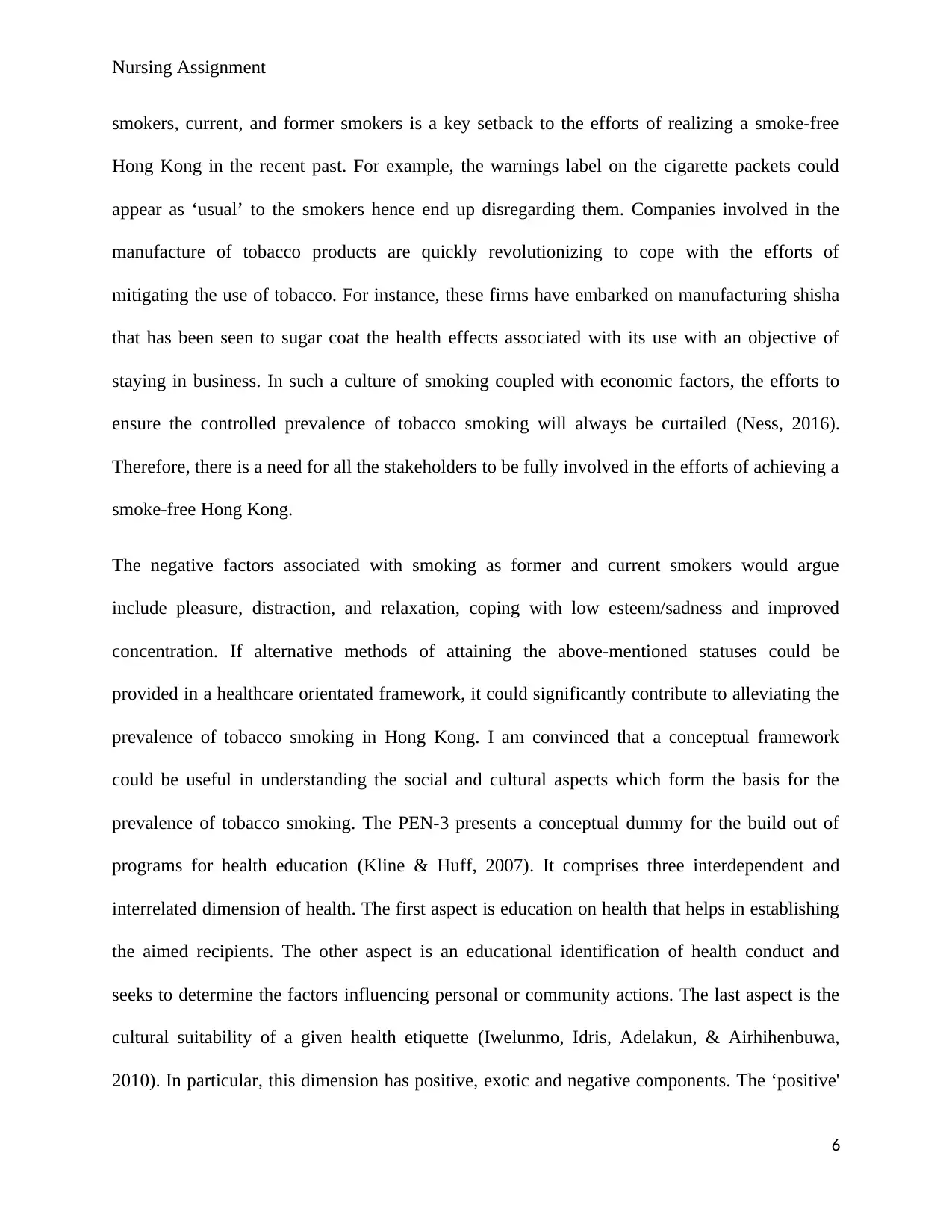
Nursing Assignment
smokers, current, and former smokers is a key setback to the efforts of realizing a smoke-free
Hong Kong in the recent past. For example, the warnings label on the cigarette packets could
appear as ‘usual’ to the smokers hence end up disregarding them. Companies involved in the
manufacture of tobacco products are quickly revolutionizing to cope with the efforts of
mitigating the use of tobacco. For instance, these firms have embarked on manufacturing shisha
that has been seen to sugar coat the health effects associated with its use with an objective of
staying in business. In such a culture of smoking coupled with economic factors, the efforts to
ensure the controlled prevalence of tobacco smoking will always be curtailed (Ness, 2016).
Therefore, there is a need for all the stakeholders to be fully involved in the efforts of achieving a
smoke-free Hong Kong.
The negative factors associated with smoking as former and current smokers would argue
include pleasure, distraction, and relaxation, coping with low esteem/sadness and improved
concentration. If alternative methods of attaining the above-mentioned statuses could be
provided in a healthcare orientated framework, it could significantly contribute to alleviating the
prevalence of tobacco smoking in Hong Kong. I am convinced that a conceptual framework
could be useful in understanding the social and cultural aspects which form the basis for the
prevalence of tobacco smoking. The PEN-3 presents a conceptual dummy for the build out of
programs for health education (Kline & Huff, 2007). It comprises three interdependent and
interrelated dimension of health. The first aspect is education on health that helps in establishing
the aimed recipients. The other aspect is an educational identification of health conduct and
seeks to determine the factors influencing personal or community actions. The last aspect is the
cultural suitability of a given health etiquette (Iwelunmo, Idris, Adelakun, & Airhihenbuwa,
2010). In particular, this dimension has positive, exotic and negative components. The ‘positive'
6
smokers, current, and former smokers is a key setback to the efforts of realizing a smoke-free
Hong Kong in the recent past. For example, the warnings label on the cigarette packets could
appear as ‘usual’ to the smokers hence end up disregarding them. Companies involved in the
manufacture of tobacco products are quickly revolutionizing to cope with the efforts of
mitigating the use of tobacco. For instance, these firms have embarked on manufacturing shisha
that has been seen to sugar coat the health effects associated with its use with an objective of
staying in business. In such a culture of smoking coupled with economic factors, the efforts to
ensure the controlled prevalence of tobacco smoking will always be curtailed (Ness, 2016).
Therefore, there is a need for all the stakeholders to be fully involved in the efforts of achieving a
smoke-free Hong Kong.
The negative factors associated with smoking as former and current smokers would argue
include pleasure, distraction, and relaxation, coping with low esteem/sadness and improved
concentration. If alternative methods of attaining the above-mentioned statuses could be
provided in a healthcare orientated framework, it could significantly contribute to alleviating the
prevalence of tobacco smoking in Hong Kong. I am convinced that a conceptual framework
could be useful in understanding the social and cultural aspects which form the basis for the
prevalence of tobacco smoking. The PEN-3 presents a conceptual dummy for the build out of
programs for health education (Kline & Huff, 2007). It comprises three interdependent and
interrelated dimension of health. The first aspect is education on health that helps in establishing
the aimed recipients. The other aspect is an educational identification of health conduct and
seeks to determine the factors influencing personal or community actions. The last aspect is the
cultural suitability of a given health etiquette (Iwelunmo, Idris, Adelakun, & Airhihenbuwa,
2010). In particular, this dimension has positive, exotic and negative components. The ‘positive'
6
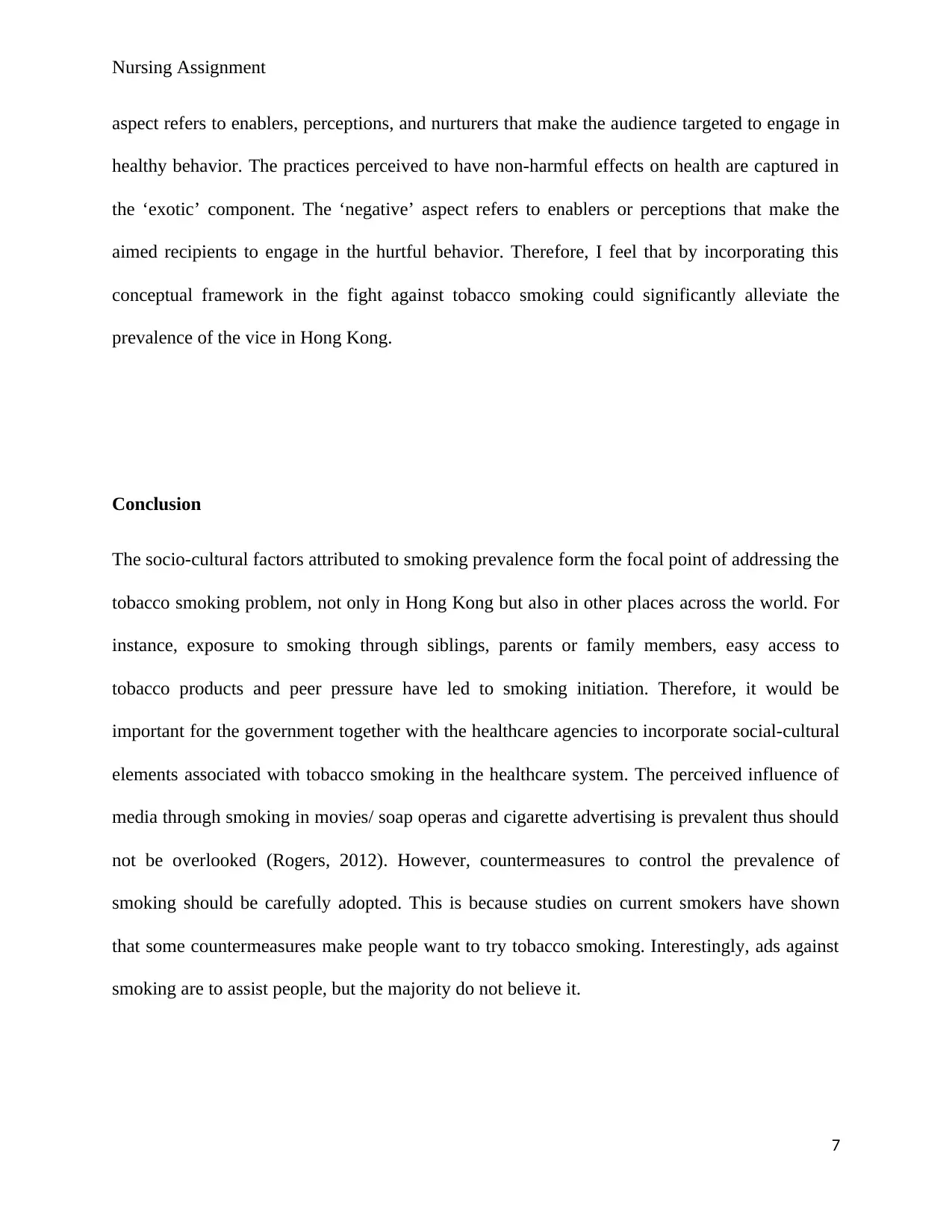
Nursing Assignment
aspect refers to enablers, perceptions, and nurturers that make the audience targeted to engage in
healthy behavior. The practices perceived to have non-harmful effects on health are captured in
the ‘exotic’ component. The ‘negative’ aspect refers to enablers or perceptions that make the
aimed recipients to engage in the hurtful behavior. Therefore, I feel that by incorporating this
conceptual framework in the fight against tobacco smoking could significantly alleviate the
prevalence of the vice in Hong Kong.
Conclusion
The socio-cultural factors attributed to smoking prevalence form the focal point of addressing the
tobacco smoking problem, not only in Hong Kong but also in other places across the world. For
instance, exposure to smoking through siblings, parents or family members, easy access to
tobacco products and peer pressure have led to smoking initiation. Therefore, it would be
important for the government together with the healthcare agencies to incorporate social-cultural
elements associated with tobacco smoking in the healthcare system. The perceived influence of
media through smoking in movies/ soap operas and cigarette advertising is prevalent thus should
not be overlooked (Rogers, 2012). However, countermeasures to control the prevalence of
smoking should be carefully adopted. This is because studies on current smokers have shown
that some countermeasures make people want to try tobacco smoking. Interestingly, ads against
smoking are to assist people, but the majority do not believe it.
7
aspect refers to enablers, perceptions, and nurturers that make the audience targeted to engage in
healthy behavior. The practices perceived to have non-harmful effects on health are captured in
the ‘exotic’ component. The ‘negative’ aspect refers to enablers or perceptions that make the
aimed recipients to engage in the hurtful behavior. Therefore, I feel that by incorporating this
conceptual framework in the fight against tobacco smoking could significantly alleviate the
prevalence of the vice in Hong Kong.
Conclusion
The socio-cultural factors attributed to smoking prevalence form the focal point of addressing the
tobacco smoking problem, not only in Hong Kong but also in other places across the world. For
instance, exposure to smoking through siblings, parents or family members, easy access to
tobacco products and peer pressure have led to smoking initiation. Therefore, it would be
important for the government together with the healthcare agencies to incorporate social-cultural
elements associated with tobacco smoking in the healthcare system. The perceived influence of
media through smoking in movies/ soap operas and cigarette advertising is prevalent thus should
not be overlooked (Rogers, 2012). However, countermeasures to control the prevalence of
smoking should be carefully adopted. This is because studies on current smokers have shown
that some countermeasures make people want to try tobacco smoking. Interestingly, ads against
smoking are to assist people, but the majority do not believe it.
7
Paraphrase This Document
Need a fresh take? Get an instant paraphrase of this document with our AI Paraphraser
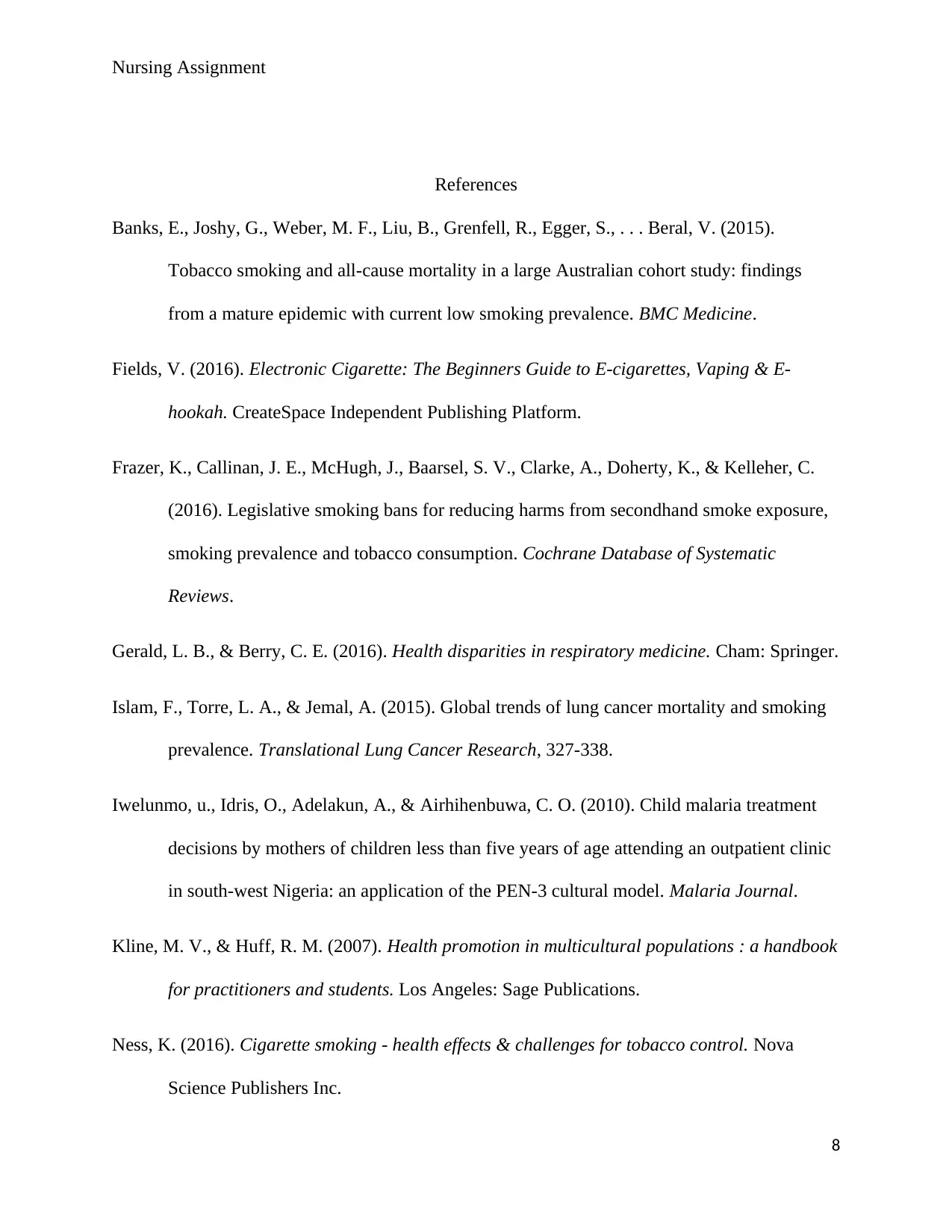
Nursing Assignment
References
Banks, E., Joshy, G., Weber, M. F., Liu, B., Grenfell, R., Egger, S., . . . Beral, V. (2015).
Tobacco smoking and all-cause mortality in a large Australian cohort study: findings
from a mature epidemic with current low smoking prevalence. BMC Medicine.
Fields, V. (2016). Electronic Cigarette: The Beginners Guide to E-cigarettes, Vaping & E-
hookah. CreateSpace Independent Publishing Platform.
Frazer, K., Callinan, J. E., McHugh, J., Baarsel, S. V., Clarke, A., Doherty, K., & Kelleher, C.
(2016). Legislative smoking bans for reducing harms from secondhand smoke exposure,
smoking prevalence and tobacco consumption. Cochrane Database of Systematic
Reviews.
Gerald, L. B., & Berry, C. E. (2016). Health disparities in respiratory medicine. Cham: Springer.
Islam, F., Torre, L. A., & Jemal, A. (2015). Global trends of lung cancer mortality and smoking
prevalence. Translational Lung Cancer Research, 327-338.
Iwelunmo, u., Idris, O., Adelakun, A., & Airhihenbuwa, C. O. (2010). Child malaria treatment
decisions by mothers of children less than five years of age attending an outpatient clinic
in south-west Nigeria: an application of the PEN-3 cultural model. Malaria Journal.
Kline, M. V., & Huff, R. M. (2007). Health promotion in multicultural populations : a handbook
for practitioners and students. Los Angeles: Sage Publications.
Ness, K. (2016). Cigarette smoking - health effects & challenges for tobacco control. Nova
Science Publishers Inc.
8
References
Banks, E., Joshy, G., Weber, M. F., Liu, B., Grenfell, R., Egger, S., . . . Beral, V. (2015).
Tobacco smoking and all-cause mortality in a large Australian cohort study: findings
from a mature epidemic with current low smoking prevalence. BMC Medicine.
Fields, V. (2016). Electronic Cigarette: The Beginners Guide to E-cigarettes, Vaping & E-
hookah. CreateSpace Independent Publishing Platform.
Frazer, K., Callinan, J. E., McHugh, J., Baarsel, S. V., Clarke, A., Doherty, K., & Kelleher, C.
(2016). Legislative smoking bans for reducing harms from secondhand smoke exposure,
smoking prevalence and tobacco consumption. Cochrane Database of Systematic
Reviews.
Gerald, L. B., & Berry, C. E. (2016). Health disparities in respiratory medicine. Cham: Springer.
Islam, F., Torre, L. A., & Jemal, A. (2015). Global trends of lung cancer mortality and smoking
prevalence. Translational Lung Cancer Research, 327-338.
Iwelunmo, u., Idris, O., Adelakun, A., & Airhihenbuwa, C. O. (2010). Child malaria treatment
decisions by mothers of children less than five years of age attending an outpatient clinic
in south-west Nigeria: an application of the PEN-3 cultural model. Malaria Journal.
Kline, M. V., & Huff, R. M. (2007). Health promotion in multicultural populations : a handbook
for practitioners and students. Los Angeles: Sage Publications.
Ness, K. (2016). Cigarette smoking - health effects & challenges for tobacco control. Nova
Science Publishers Inc.
8
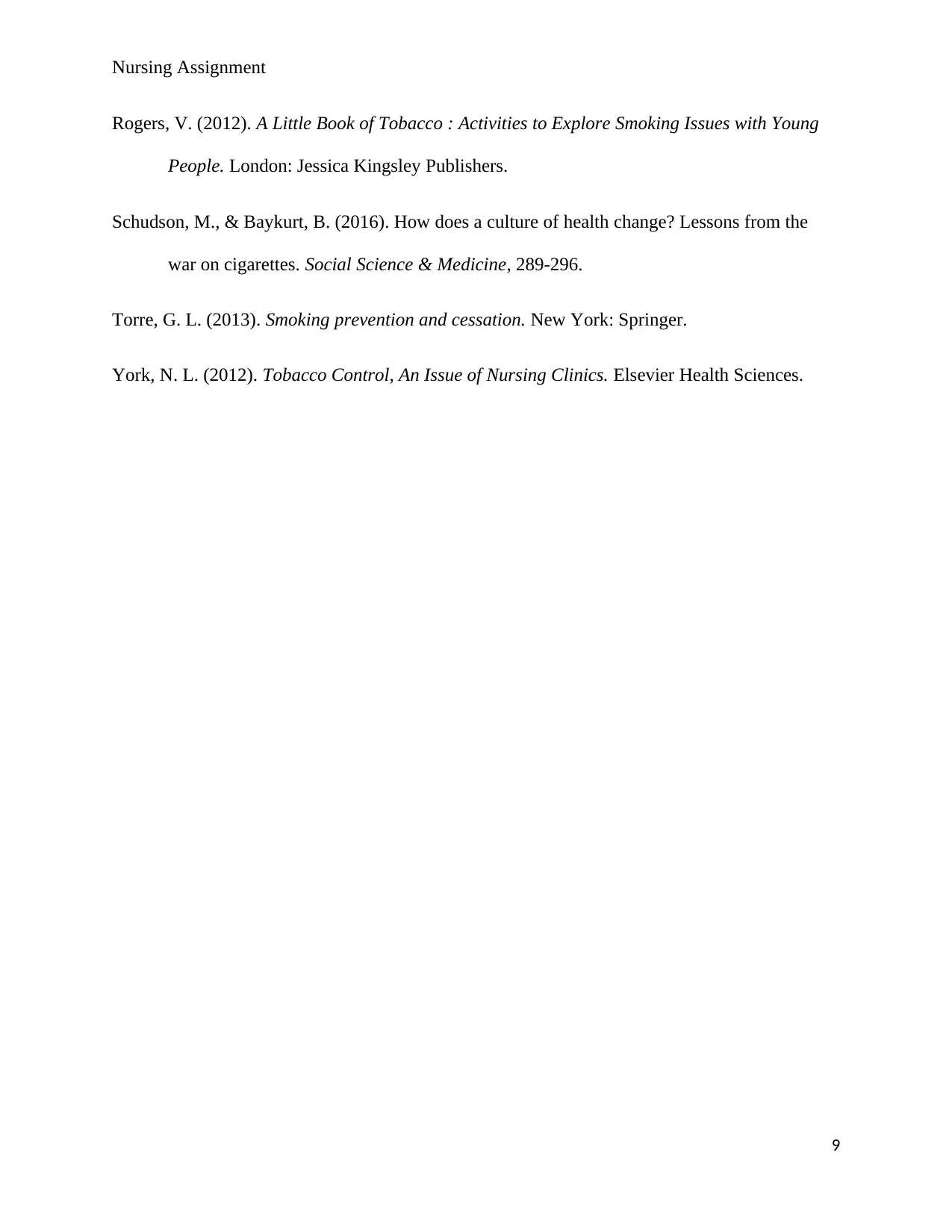
Nursing Assignment
Rogers, V. (2012). A Little Book of Tobacco : Activities to Explore Smoking Issues with Young
People. London: Jessica Kingsley Publishers.
Schudson, M., & Baykurt, B. (2016). How does a culture of health change? Lessons from the
war on cigarettes. Social Science & Medicine, 289-296.
Torre, G. L. (2013). Smoking prevention and cessation. New York: Springer.
York, N. L. (2012). Tobacco Control, An Issue of Nursing Clinics. Elsevier Health Sciences.
9
Rogers, V. (2012). A Little Book of Tobacco : Activities to Explore Smoking Issues with Young
People. London: Jessica Kingsley Publishers.
Schudson, M., & Baykurt, B. (2016). How does a culture of health change? Lessons from the
war on cigarettes. Social Science & Medicine, 289-296.
Torre, G. L. (2013). Smoking prevention and cessation. New York: Springer.
York, N. L. (2012). Tobacco Control, An Issue of Nursing Clinics. Elsevier Health Sciences.
9
1 out of 9
Related Documents
Your All-in-One AI-Powered Toolkit for Academic Success.
+13062052269
info@desklib.com
Available 24*7 on WhatsApp / Email
![[object Object]](/_next/static/media/star-bottom.7253800d.svg)
Unlock your academic potential
© 2024 | Zucol Services PVT LTD | All rights reserved.





